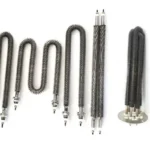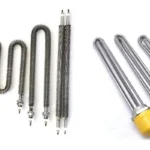Are you cold and looking for a good heater? Or maybe you need a heater for your business? Tubular heaters might be what you need. But what exactly are they?
Tubular heaters are versatile heating elements used in many places. They convert electrical energy into heat through a simple design. They have a metal tube containing a resistance coil, insulated by a ceramic material. This design allows for efficient and consistent heat distribution.
Tubular heaters have many uses. To understand them better, let’s look at some common questions I often get.
What Is a Tubular Heater? A Beginner’s Guide to Uses, Safety, and Efficiency?
Are you not sure what a tubular heater really does? Or where it’s used? Let’s break it down.
A tubular heater is an electrical heating device. It is shaped like a tube. It provides heat in a controlled way. You can find them in homes, businesses, and industries. They are used for things like heating rooms, keeping pipes from freezing, and warming up machines.
Delving Deeper into Tubular Heater Uses
Tubular heaters are truly versatile because of their simple design and effective heating capabilities. They can be used for so many different applications. Here is a more detailed look:
| Use Case | Description | Benefits |
|---|---|---|
| Home Heating | Small tubular heaters keep rooms warm. They are often used in closets or small spaces. | Energy-efficient, prevents dampness, maintains a constant temperature. |
| Industrial Heating | Larger tubular heaters heat tanks, fluids, and machinery. | Durable, provides high heat output, customizable to fit specific equipment. |
| Freeze Protection | Heaters placed along pipes prevent freezing in cold weather. | Prevents costly damage from burst pipes, maintains flow in essential systems. |
| Food Warming | Tubular heaters keep food warm in restaurants and catering services. | Maintains food temperature, prevents bacterial growth, ensures food safety. |
| Medical Equipment | Used in sterilizers and incubators to maintain constant temperatures. | Accurate, reliable, durable. |
As you can see, the benefits of tubular heaters come from their ability to deliver consistent and reliable heat. I remember one time a client came to us with frozen pipes bursting every winter. We installed tubular heaters along their pipes. They never had that problem again! This shows how important and helpful these heaters can be.
Top 5 Tubular Heaters with Built-In Thermostats for Energy Savings in 2025?
Do you want to save money on your energy bill? Are you looking for the best tubular heaters? A built-in thermostat can help.
Tubular heaters with built-in thermostats help save energy. These thermostats control the heater’s temperature. This prevents the heater from running too much. Some of the best models in 2025 include those with digital controls and energy-efficient designs.
Dive Deeper into Energy Savings
The key to saving energy with tubular heaters lies in their thermostats. These thermostats allow precise temperature control. This reduces energy waste and lowers electricity bills. Here’s a breakdown of how these features work:
| Feature | Description | Energy Saving Benefit |
|---|---|---|
| Digital Thermostats | Offer precise temperature settings. Users can set the exact temperature they need. | Prevents overheating and wasted energy. Maintains consistent temperatures, reducing fluctuations. |
| Adjustable Thermostats | Allow users to adjust the temperature manually. This is good for different heating needs. | Adaptable to changing conditions, avoids unnecessary heating when full power isn’t required. |
| Timer Settings | Some models have timers. These timers allow you to set when the heater turns on and off. | Reduces energy use by only heating when needed. Perfect for scheduled heating, like during specific work hours. |
| Energy-Efficient Design | Modern tubular heaters are designed to maximize heat output. They minimize energy consumption. | Heats up faster and more efficiently, reducing the amount of time the heater needs to run. |
| Smart Features | Some heaters can connect to smart devices. This allows for remote control and monitoring. | Users can monitor and adjust settings from anywhere, optimizing energy use based on real-time needs. |
I’ve seen how effective these features can be. One customer replaced their old heater with a model with a digital thermostat and timer. Their energy bills decreased by 20% in the first month! These technologies really make a difference.
Are Tubular Heaters Expensive to Run? Breaking Down Costs and Efficiency?
Are you worried about the cost of running a tubular heater? Let’s look at the real costs and how efficient they are.
Tubular heaters are generally cost-effective to run. Their energy use depends on their wattage and how long they are used. Models with thermostats and energy-efficient designs help reduce running costs. By choosing the right size and using it wisely, you can keep costs down.
Dive Deeper into Costs and Efficiency
To understand the costs, you need to look at wattage, usage, and efficiency. Here’s a breakdown:
| Factor | Description | Impact on Cost |
|---|---|---|
| Wattage | The amount of electricity the heater uses. Lower wattage heaters use less energy. | Lower wattage means lower electricity bills. Choose a wattage that matches the space. |
| Usage Hours | How many hours a day the heater is running. Reducing usage can significantly lower costs. | Shorter usage times mean lower energy consumption. Use timers to control when the heater runs. |
| Thermostat Use | Using a thermostat to control the temperature. Prevents the heater from running continuously. | Maintains a consistent temperature. Reduces energy waste by only running when needed. |
| Insulation | Insulating the room or area being heated. Keeps the heat in and reduces the heater’s workload. | Better insulation means less heat loss. The heater doesn’t have to work as hard to maintain the temperature. |
| Energy Efficiency | Look for heaters with energy-efficient designs. These models convert more electricity into heat. | Efficient heaters provide more heat for the same amount of energy. Look for models with high energy efficiency ratings. |
I always tell my customers to think about how they will use the heater. A small, energy-efficient model with a thermostat is perfect for a small space that needs constant, low-level heat. This approach helps minimize costs.
How to Install a Wall-Mounted Tubular Heater: Step-by-Step Safety Tips?
Do you want to install a tubular heater on your wall? It’s important to do it safely.
Installing a wall-mounted tubular heater involves a few key steps. First, turn off the power. Then, mount the heater securely to the wall using the provided brackets. Ensure proper wiring and connections. Always follow the manufacturer’s instructions and safety guidelines.
Dive Deeper into Installation and Safety
Safe installation is crucial. It protects you and ensures the heater works correctly. Here’s a step-by-step guide with safety tips:
| Step | Description | Safety Tip |
|---|---|---|
| 1. Preparation | Gather all necessary tools and materials. Read the manufacturer’s instructions. | Ensure you have the right tools. Wear safety glasses and gloves. |
| 2. Power Off | Turn off the power at the circuit breaker. Confirm the power is off using a voltage tester. | Always turn off the power before working with electrical components. |
| 3. Mounting Brackets | Mark the location for the mounting brackets. Use a level to ensure they are straight. | Use appropriate screws and anchors for your wall type. Ensure the brackets are securely attached. |
| 4. Heater Placement | Attach the heater to the mounting brackets. Make sure it is stable and secure. | Avoid placing the heater near flammable materials. Ensure adequate space around the heater for ventilation. |
| 5. Wiring Connections | Connect the heater’s wires to the power supply. Follow the wiring diagram provided by the manufacturer. | Double-check all connections. Use wire connectors to ensure secure and insulated connections. If unsure, consult a qualified electrician. |
| 6. Testing | Turn the power back on at the circuit breaker. Test the heater to ensure it is working correctly. | Monitor the heater for any unusual noises or smells. If you notice anything, turn off the power immediately and consult a professional. |
I can’t stress enough how important it is to follow safety guidelines. A friend of mine tried to install a heater without turning off the power. He got a shock and had to go to the hospital. Always be careful!
Industrial vs. Home Use: Choosing the Right Tubular Heater for Your Space?
Do you need a heater for your home or for industrial use? The right choice depends on your needs.
For home use, smaller, energy-efficient tubular heaters are often best. Industrial settings require more robust and powerful heaters. Consider the size of the space, the required heat output, and energy efficiency when choosing the right heater.
Dive Deeper into Choosing the Right Heater
Choosing the right tubular heater involves thinking about the specific needs of your space. Here’s a detailed comparison:
| Feature | Home Use | Industrial Use |
|---|---|---|
| Size and Capacity | Smaller heaters with lower wattage. Suitable for heating small rooms or closets. | Larger, high-wattage heaters. Designed for heating large areas, tanks, or machinery. |
| Durability | Designed for occasional use. Not as robust as industrial models. | Built for continuous, heavy-duty use. Made with durable materials to withstand harsh conditions. |
| Energy Efficiency | Energy-efficient models are preferred. Focus on low energy consumption and cost savings. | Efficiency is important, but power is often the priority. Look for models that balance efficiency and high heat output. |
| Safety Features | Standard safety features like overheat protection. | Additional safety features are required, such as explosion-proof designs for hazardous environments. |
| Cost | Generally less expensive. | More expensive due to the robust construction and specialized features. |
| Specific Needs | Consider your specific needs. Will the heater be used for frost protection? Is temperature control a high priority? | Industrial applications often have specific needs. Consider the material to be heated, the operating environment, and the desired temperature. |
I’ve helped many customers choose the right heater for their needs. One business needed heaters for a large warehouse. They needed powerful, durable heaters that could handle constant use. I recommended heavy-duty industrial models.
Conclusion
Tubular heaters are useful for many things. Knowing how they work, how to use them safely, and how to choose the right one can help you get the most out of them. They can be a good choice for both home and industrial use.











